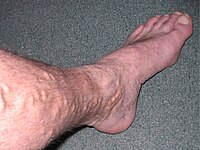
Photo from wikipedia
Background. Associating liver partition and portal vein ligation for staged hepatectomy (ALPPS) is used to accelerate growth of the future liver remnant. We investigated alternative methods for increasing the future… Click to show full abstract
Background. Associating liver partition and portal vein ligation for staged hepatectomy (ALPPS) is used to accelerate growth of the future liver remnant. We investigated alternative methods for increasing the future liver remnant. Methods. A total of 152 rats were randomized as follows: (1) sham; (2) portal vein ligation; (3) portal vein ligation/surgical split (ALPPS); (4) portal vein ligation/split of the liver with a radiofrequency ablation needle; (5) portal vein ligation/radiofrequency ablation of the deportalized liver (portal vein ligation/radiofrequency ablation necrosis in the deportalized liver); (6) portal vein ligation/radiofrequency ablation of the future liver remnant (portal vein ligation/radiofrequency ablation–future liver remnant); and (7) controls. Animals were evaluated on postoperative days 2 and 4. Bodyweight, liver parameters, hepatic regeneration rate, proinflammatory cytokines, hepatocyte proliferation, and gene expression were measured. Results. Hepatic regeneration rate indicated a steady increase in all intervention groups compared with sham rats (P < .001). At postoperative day 2, the hepatic regeneration rate was significantly higher in the portal vein ligation/radiofrequency ablation necrosis in the deportalized liver group than in the portal vein ligation group (P = .039). On postoperative day 4, we found significant differences between the portal vein ligation group and the ALPPS (P = .015), portal vein ligation/split of the liver with a radiofrequency ablation needle (P = .010), and portal vein ligation/radiofrequency ablation necrosis in the deportalized liver (P = .046) groups. Hepatocyte proliferation was significantly higher at all times compared with sham rats. On postoperative day 4, we found a significantly higher proliferation in groups 3, 4, 5, and 6 compared to portal vein ligation. Gene analysis revealed upregulation of genes involved in cellular proliferation and downregulation of genes involved in cellular homeostasis in all intervention groups. Between the intervention groups, gene expression was nearly identical. Biochemical markers and proinflammatory cytokines were comparable between groups. Conclusion. The surplus liver regeneration after ALPPS is probably mediated through parenchymal damage and subsequent release of growth stimulators, which again upregulates genes involved in cellular regeneration and downregulates genes involved in cellular homeostasis. We also demonstrate that growth of the future liver remnant, comparable to that seen after ALPPS, could be achieved by radiofrequency ablation treatment of the deportalized liver, that is, a procedure in which the initial step in humans can be performed percutaneously.
Journal Title: Surgery
Year Published: 2017
Link to full text (if available)
Share on Social Media: Sign Up to like & get
recommendations!